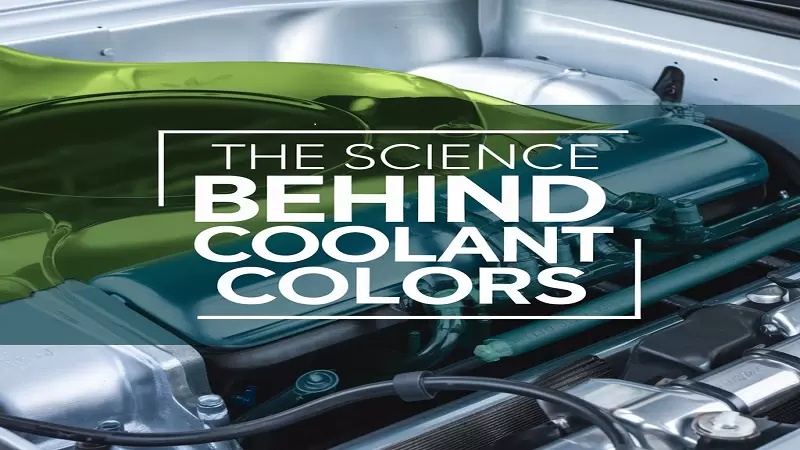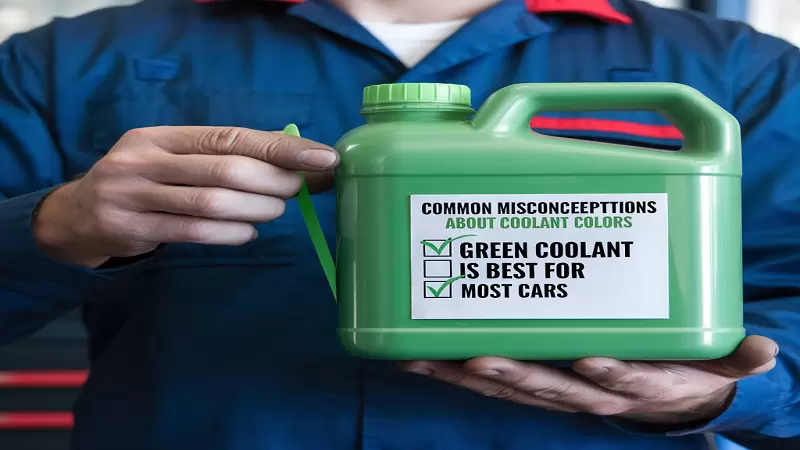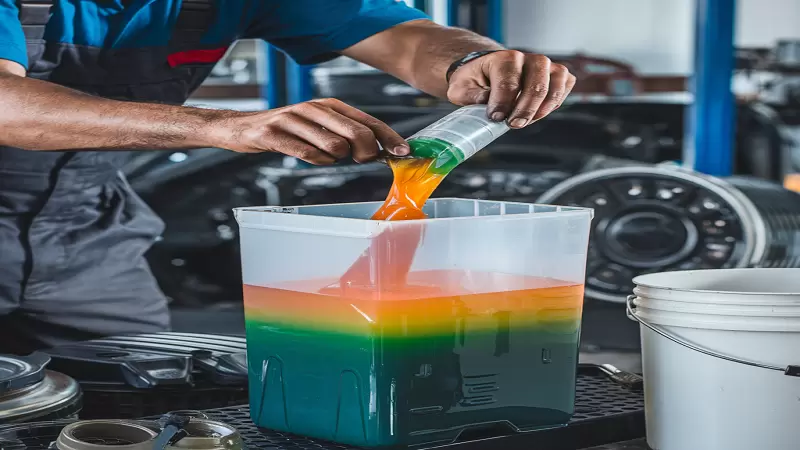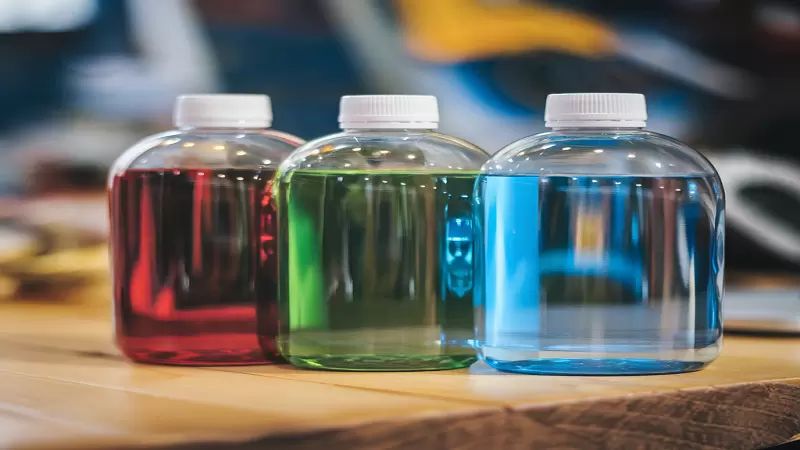Ever opened up the hood of your car and wondered about the different colors of that fluid that maintains the temperature of your engine?
You are not on your own. The realm of engine coolants is a colorful one from dazzling neon shades to calmer hues.
But these aren’t just to show each Coolant Different Colours tells a story about its composition and purpose. Let’s go deeper in the exciting world of antifreeze coolant and explain what all these different colors mean.
Why Does Coolant Come in Different Colors?
People often think that marketing is behind the different colors of coolants, but they are wrong. The intention behind this hue is to assist vehicle mechanics and proprietors in distinguishing among various varieties of coolants effortlessly.
Here’s the scoop:
- Color coding: Coolant types are marked by various colors in manufacturers’ use.
- Chemical composition: The dye added to coolant reflects its unique chemical makeup.
- Quick identification: Colors make it easy to spot coolant leaks and avoid mixing incompatible types.
Think of Coolant Different Colours as a secret language your car uses to communicate its needs. Pretty cool, right?
The Rainbow of Coolant Different Colours
Let’s break down the most common Coolant Different Colours you’ll encounter:
Green Coolant: The OG of Antifreeze
In the realm of coolants, there exists a specific green variety that is the oldest among them all. It is still valid today, having existed since the decade of 1920s.
Key features:
- Contains silicates and phosphates for corrosion protection
- Usually requires swapping out at intervals of 30,000 miles or 2 years.
- Vehicles that are suitable for those made before 1990s
Orange Coolant: The Modern Marvel
In the mid 1990s an unusual orange coolant came out giving a significant boost to the entire cooling system.
Characteristics:
- Organic Acid Technology (OAT) is used.
- Can last for up to a hundred and fifty thousand miles or even five years.
- Found in many GM and some European vehicles
Blue Coolant: The Euro Flavor
Blue coolant is often associated with European manufacturers though it’s not exclusive to them.
Notable points:
- Phosphate-free formulation
- Volkswagen Audi and Porsche models are often made use of.
- May have the ability to serve for a period extending as long as four years or fifty thousand miles.
Pink and Red Coolants: The Asian Invasion
These rosy hues are frequently found in Asian made vehicles.
What to know:
- Often based on Organic Acid Technology (OAT)
- Utilized by Toyota, Lexus and a few models of Hyundai
- It is possible that it can endure even as much as a hundred thousand miles or five years
Yellow Coolant: The Hybrid Solution
Yellow coolant represents a blend of technologies, offering a middle ground.
Key aspects:
- Uses Hybrid Organic Acid Technology (HOAT)
- Found in some Ford and Chrysler vehicles
- Service interval typically around 5 years or 100,000 miles
The Science Behind Coolant Colors

Today, let’s get nerdy a little. The change from winter season to summer season in frost and snow can not merely be a question of aesthetics; it is all about performing its chemical activities.
Chemical composition affects color:
- Ethylene glycol (the base of most coolants) is naturally colorless
- Dyes are added to indicate different chemical additives
- The specific blend of corrosion inhibitors influences the final hue
Here’s a quick reference table:
| Color | Base Technology | Typical Lifespan | Common Vehicle Makes |
| Green | IAT (Inorganic Acid Technology) | 2 years / 30,000 miles | Older vehicles (pre-1990s) |
| Orange | OAT (Organic Acid Technology) | 5 years / 150,000 miles | GM, some European |
| Blue | Phosphate-free OAT | 4 years / 50,000 miles | VW, Audi, Porsche |
| Pink/Red | OAT or HOAT | 5 years / 100,000 miles | Toyota, Lexus, some Hyundai |
| Yellow | HOAT (Hybrid Organic Acid Technology) | 5 years / 100,000 miles | Ford, Chrysler |
Do I Need to Use a Specific Color of Coolant in My Car?
Now, this is the time when everyone has to be serious. Using the wrong coolant; it is just like giving the engine a wrong cocktail. It could run but not be happy.
Why coolant compatibility matters:
- Different coolants have unique chemical compositions
- Mixing incompatible coolants can lead to gel formation or corrosion
- Using the wrong type can void your vehicle’s warranty
Best practices:
- Always consult your owner’s manual first
- Stick coolants recommended by producer
- In case you are not sure, consult an experienced automobile expert.
“An engine can have some serious problems unless it is regularly serviced with the right kind of coolant,” says John Smith, ASE Certified Master Technician. “Preventing overheating is not the only reason why; there are also other reasons like avoiding corrosion on your engine and achieving good performance.”
The Evolution of Coolant Technology
Coolant Different Colours has evolved a lot since it was first produced. Let’s travel back in time:
- 1890s: The first antifreeze solutions were simply alcohol-based
- 1920s: Ethylene glycol-based coolants introduced (the classic green)
- 1990s: Extended life coolants (orange) hit the market
- 2000s: Specialized formulations for different vehicle types emerge
This evolution mirrors the advancements in engine technology. As engines became more complex and used different metals, coolant formulations had to keep pace.
Prestone Coolant: A Case Study in Versatility
Prestone, a well-known name in the world of car coolants, offers an interesting case study in coolant evolution.
Prestone’s approach:
- Developed a universal coolant compatible with all makes and models
- Color: Yellow (but don’t let that fool you it’s designed to mix with other colors)
- Utilizes patented Cor-Guard™ agents for preventing rust
Preston universal coolant is a perfect alternative nonetheless one should always confirm the specifications of their car before they make any decision.
Common Misconceptions About Coolant Colors

Let’s bust some myths about Coolant Different Colours:
- Myth: All green coolants are the same Fact: While most green coolants are IAT-based, some newer formulations use different technologies
- Myth: You can mix coolants of the same color Fact: Color alone doesn’t guarantee compatibility – always check the coolant type
- Myth: Coolant color indicates its freezing point Fact: Freezing point depends on the concentration of antifreeze, not its color
- Myth:It means that it’s time to have it replaced. The truth is that changing color alone cannot be a sure sign of coolant quality – pH and freezing point must be tested always.
How to Choose the Right Coolant for Your Car
Choosing the right Coolant Different Colours needn’t be a headache. Follow these steps:
- Check your manual: Always start here for the manufacturer’s recommendation
- Know your vehicle’s age: Older cars might need different coolants than newer models
- Consider your climate: Extreme temperatures might influence your coolant choice
- Look for compatibility: If switching brands, ensure the new coolant is compatible with your current one
- Consult a professional:Sometimes, it is difficult to share one’s pain with others. In such cases, the best choice would be to consult an experienced automobile technician about it.
- It’s called attention to that suitable antifreeze is essential for both your engine’s wellbeing and peace of mind.
The Future of Coolant Technology
As Coolant Different Colours improves with advancements in automotive technology, what could be in store for the future?
Emerging trends:
- Biodegradable coolants: Environmentally friendly options are gaining traction
- Nanotechnology: Some researchers are exploring nanoparticle enhanced coolants for better heat transfer
- Smart coolants: Future coolants might change color to indicate their condition or the engine’s health
Even though these technologies are really interesting, it is better to use manufacturer’s approved coolants for the time being.
Coolant Maintenance: Best Practices
Knowing about Coolant Different Colours is great, but proper maintenance is key. Here are some tips:
- Regular checks: Inspect your coolant level and color monthly
- Flush on schedule: Follow your manufacturer’s recommended coolant change intervals
- Use distilled water: To prevent accumulation of minerals always use distilled water when refilling.
- Check for leaks:Coolant leaks must be attended to immediately in order to avoid ruining the engine
- Test periodically: Check the coolant’s pH and freezing point annually
Sarah Johnson, who specializes in automotive at Tech Auto Center, denotes that proper maintenance of Coolant Different Colours extends one’s engine life and averts expensive repairs. “In the long term it is a small effort which gives great rewards,” she commented.

Coolant Colors: A Spectrum of Engine Protection
The Diversity of Coolant Hues
Engine coolants come in a vibrant array of colors, each one serving a distinct purpose. These shades aren’t mere aesthetics – they’re a secret language your car uses to communicate its needs.
Green Coolant: The Timeless Classic
The traditional green coolant has been around since the 1920s. It contains silicates and phosphates to guard against corrosion, making it suitable for older vehicles from the pre-1990s era. While it may not be the newest kid on the block, this OG of coolants continues to play a vital role in keeping engines running smoothly.
The Rise of Modern Marvels
In the mid-1990s, a revolutionary orange coolant emerged, boasting Organic Acid Technology (OAT). This advanced formula can last up to a remarkable 150,000 miles or even 5 years, making it a popular choice for many GM and European models.
Exploring the Coolant Color Spectrum
Beyond the classic green and the modern orange, the coolant world offers an array of hues, each with its own unique characteristics:
Blue Coolant: The European Flair
Frequently associated with European manufacturers like Volkswagen, Audi, and Porsche, blue coolant features a phosphate-free OAT formulation. This specialized blend can serve vehicles for up to 4 years or 50,000 miles.
Pink and Red Coolants: The Asian Influence
These rosy hues are often found in Asian-made vehicles, such as Toyota, Lexus, and some Hyundai models. These coolants are also based on Organic Acid Technology (OAT) or Hybrid Organic Acid Technology (HOAT), and can last for up to 100,000 miles or 5 years.
Yellow Coolant: The Hybrid Solution
Representing a blend of technologies, yellow coolant utilizes Hybrid Organic Acid Technology (HOAT). This middle-ground option is commonly used in Ford and Chrysler vehicles, with a typical service interval of 5 years or 100,000 miles.
The Science Behind the Colors
The diverse hues of coolants aren’t just for show – they reflect the unique chemical compositions that make each type suited for specific applications. The base of most coolants, ethylene glycol, is naturally colorless, but dyes are added to indicate the different corrosion inhibitors and additives present.
Coolant Compatibility: Avoiding Costly Mistakes
It’s crucial to use the right coolant for your vehicle, as mixing incompatible formulas can lead to disastrous consequences, from gel formation to corrosion. Always consult your owner’s manual and, if in doubt, seek the guidance of an experienced automotive expert.
Maintaining Coolant Health: A Proactive Approach
Regular coolant checks, flushes, and testing are essential to ensure your engine’s cooling system remains in top condition. By staying on top of coolant maintenance, you can extend the life of your vehicle and avoid expensive repairs down the line.
As automotive technology continues to evolve, the world of engine coolants is sure to see even more advancements. But for now, understanding the Coolant Different Colours and their specific applications remains a vital part of responsible vehicle ownership.
FAQ:
Q1: Can I mix different colors of coolant in my car?
A: It’s best not to mix Coolant Different Colours. Each color represents a specific formulation designed for certain types of engines. If we combine them together there might be chemical reactions resulting in decreased efficiency of coolants or even destruction. In case of any doubt regarding the contents of your system it is better to clean it out entirely before topping it up with fresh coolant. Always refer to your automobile’s manual for the appropriate type. If by mistake you’ve intermingled some antifreeze or coolants, don’t fret, simply flush out the entire cooling system quickly and put in the proper kind of liquid thereafter. Remember, color alone doesn’t determine compatibility, so never mix coolants based solely on appearance.
Q2: How often should I change my coolant?
A:The peace we obtain from a vehicle’s low quince acid depends on the method of production and its technological advancements. Hardly do we see green color related to the lower quinic acid, this calls for changing after every two years or thirty thousand megameters. On the other hand, extended-life cooling fluids which are often orange, yellow or pink last up to five years or one hundred thousand kilometers. Nevertheless these are just basic suggestions. However it is also important to know that different makes have separate manuals that offer real advice about their machines. Driving behavior can also determine how long Coolant Different Colours take before getting old so finding out how they serve under different roads may require a mechanic’s attention. In case you see any differences regarding color, viscosity or volume make sure you think of replacing this liquid regardless of distance travelled or duration elapsed.
Q3: Is Prestone coolant compatible with all cars?
A: Prestone presents a number of its products that are commonly termed as “universal” coolants made to suit any automobile. Their use on coolants of different colors and types does not trigger any negative reactions. Nevertheless, it is advisable that you consult your car’s manual first even though Prestone coolant is safe for use in most cars. This is due to the fact that some luxurious or performance vehicles may have their own specifications regarding coolant. Where there is switch from another brand/type of a Coolant Different Colours into Prestone, complete flushing of a cooling system should be done before proceeding with adding in fresh prestone into its places. This ensures optimal performance and prevents any potential issues from mixing different formulations.
Conclusion: The Importance of Understanding Coolant Colors
From the conventional green to modern yellow and orange we have explored this lively universe of engine coolants. Knowing what each of these colors means is not only a matter of satisfying curiosity, but also for being a responsible vehicle owner.
Knowing your Coolant Different Colours helps you:
- Maintain your engine properly
- Avoid costly mixing mistakes
- Spot potential issues early
Remember, while Coolant Different Colours are a helpful guide, always refer to your owner’s manual and consult professionals when in doubt. Your motor will be grateful!
So next time you lift that bonnet and notice that bright fluid, you will realize that it is more than it appears. It is keeping your engine cool and your auto performing correctly, no matter what shade of refreshing is relaxing under the hood!

With over 5 years of dedicated experience in the automotive industry, I am passionate about all things automotive. My journey began with a deep curiosity for automobiles, which led me to delve deeper into their mechanics, technology and trends. My expertise spans various aspects of the automotive world, from the latest electric vehicles to classic car restoration techniques. Through my articles, I aim to share my knowledge and insights, helping readers stay informed and inspired in the fast-paced world of the automobile.











